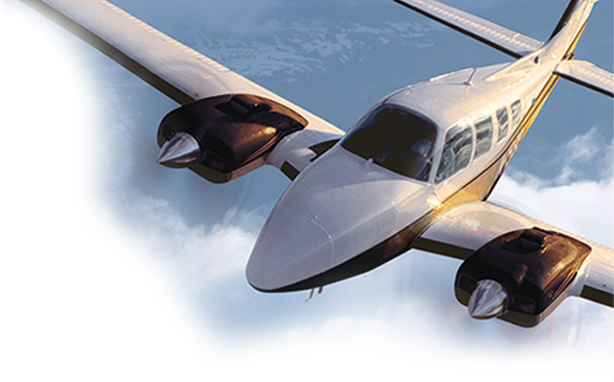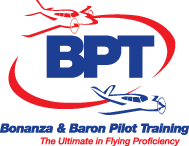Bonanza and Baron Descents without Harm or Alarm
By Hank Canterbury
Seems a lot of pilots have concerns about how to descend and not harm their engines. There are lots of questions and misinformation floating around. Descent time becomes like the old movie drama, “The Perils of Paulene.” “How should I handle power reductions? I’ve heard I should only reduce manifold pressure [MP] 1or 2 inches per minute? What airspeed to use? How to accommodate a passenger’s sensitive ears? Will doing any of this cause the dreaded “shock cooling”? ATC often delays my descents causing a lot of stress and extra maneuvering to get down—how can I handle those situations?”
All good questions. We need a flexible range of descent options in our tool bag from which to choose that will not do harm to engines and still get the job done. This subject turns out to be rather broad, covering various combinations while addressing existing concerns. My intent is to broadly address the choice of techniques; not to be proscriptive and rule out solutions not mentioned. It’s up to any pilot to choose what he or she needs to do from what is possible. Don’t unnecessarily limit your choice worrying about some unsubstantiated assertion.
Let’s begin with cylinder head temperature [CHT] and engine concerns that seem to get pilots’ attention. When using reduced power settings, your CHTs will decrease from cruise, but in most cases, they will remain within the designed ranges. Despite the persistent narrative that power reductions and descents can cause “shock cooling,” according to the experts at General Aviation Modifications, Inc. [GAMI] who have examined lots of engine data, no scientific data confirms the anecdotal episodes. The story has been reinforced over the years by some engine monitor manufactures that suggest you set up warnings to flash when some unspecified limit is reached.
Let’s look at some sensible techniques that will relieve your anxiety, save Paulene, and get the job done simply.
There are multiple techniques for descent: lower pitch only; reduce power; deploy some drag; or a combination of those options. Consider that during any descent lasting over a few seconds, the rate and the airspeed are functions of descent flight path angle, and power / drag. All of these must be manipulated progressively to achieve a desired steady state condition. We have several tools to control the outcome. Let’s see how we can combine and employ them to achieve the desired results without concern about causing damage.
Descending? First decide what rate you need, how much altitude to lose, and what speed you will maintain. To start down, simply change the flight path angle by some amount. Once the desired pitch is established, maintain whatever speed you want with power or drag devices. Descent can begin in several ways:
- Lower the pitch without reducing power — and just accept the increasing airspeed as you progress. At some point, you will need to stop the airspeed buildup by reducing power or increasing drag.
- Lower pitch and reduce power while maintaining the same speed. You will not harm your engine.
- Lower pitch, reduce power and deploy some drag. This is better yet.
If the plane is trimmed and not on autopilot, reducing power or increasing drag will cause the plane to lower the pitch and begin a descent while maintaining the same trimmed airspeed as before!
Admonitions and myths persist that Bonanzas and Barons can’t descend and slow down, and significant power reductions may cause engine damage. Let’s examine these further with a view to gaining confidence that our techniques won’t create harm.
Engine concerns seem to predominate any discussion about descents and power reductions. Here’s what Continental’s TSIO-520 Operator’s Manual says for factory turbo charged engines, which are mistakenly characterized as ‘tender’ (which they are not).
“Rapid descents at high RPM and idle manifold pressure are to be avoided. If power must be reduced for long periods (later defined as over 5 minutes) adjust propeller to minimum governing RPM and set manifold pressure no lower than necessary to obtain desired performance.” (This guidance is also intended to reduce the likelihood of de-tuning or damaging the crankshaft counter-weights).
So, let’s start with that guidance as a lower power limit. If Continental considers it OK to reduce power that low from cruise settings without causing violence to either their guidance or the engine, why should you be so concerned? Any value of MP above idle would be within limits. There are times – like an emergency descent – where idle throttle and high drag are exactly what we want to do. For that reason, it is recommended in the Emergency section of your pilot’s operating handbook [POH]. For now, we don’t need to do that every time. I’ll talk about that in the next article.
CHTs and ‘shock cooling’. Usually, we try to maintain our CHTs in a range between 2900F to near 4000F. It has been strongly suggested to not operate above 3800F for extended periods. Keep in mind that the manufacturer designed their engines to operate in a wide temperature range without damage (2000 to 4600 F per POH).
Here’s a significant data point from long time Continental chief engineer Carl Goulet: Continental’s liquid cooled engine — with the same parts and metal as ours — was thermostatically set to operate full time at 2400 F! That water-jacketed engine flew around the world non-stop in the Voyager. It appears cooler is better. So why does the admonition about letting CHTs decrease still exist?
Despite continuing anecdotal stories about “shock cooling” damaging the engine, experienced people who have examined lots of engine operating data have not found confirming evidence to support that contention. Yes, dissimilar metals have different expansion / contraction rates, but designers took those tolerances into consideration when they built our engines, enabling them to function in a relatively wide range of temperatures. It remains to be proven that “shock cooling” exists.
How much and how fast can I reduce the power without harming my engine? Contrary to what you may have heard not to reduce MP more than 2 inches per minute which is ridiculous, moving throttle and rpm smoothly to significantly lower settings than used in cruise will not damage the engine or turbo nor “shock cool” them. Nowhere is there admonition to reduce MP at such an excruciatingly slow rate, even turbocharged engines. Ever hear of “shock heating” on takeoff by exceeding 1-2 inches per minute? Certainly, that would make for a long takeoff roll.
Regarding mixture and manifold pressure, please keep several things in mind. When we descend, MP will increase 1 inch per thousand feet, unless you have an altitude compensating fuel pump (ACFP), which progressively adds fuel flow as you descend to keep up with increasing MP. IF you do not reduce throttle (MP) during the descent, you will also need to make one or more small mixture adjustments.
While fuel flow remains constant, increasing MP leans the engine, as increased air mass is entering the combustion chamber. When the engine begins to feel a bit rough, add a twist or so to increase full flow (1-2 gph) to smooth it out. On the other hand, if you progressively reduce or simply maintain a MP as you descend, you can then maintain a steady airspeed, and will likely not have to make mixture adjustments. If adjustments are needed they will be small. All turbocharged engines, as well as some normally aspirated engines, have an ACFP.
Top of Descent (ToD)
Without adding drag, here’s a suggested setup. This technique works equally well with both normally aspirated and turbo charged engines. At cruise, reduce rpm to 2300 and start down. Then reduce MP by whatever amount you need to achieve the desired rate. You can even go to 15 inches if desired, which is the bottom of green arc. To further increase descent rate simply reduce rpm as desired or needed, all the way to bottom of green arcs (1,800 for single-engine or 2,100 for twin-engine aircraft). As you continue descent you must occasionally adjust throttle, as MP will rise–just maintain it in the range you select.
Your descent rate will be substantial, and it can be readily modulated to any lesser rate desired. Most of us will just reduce throttle first. A simple rule of thumb is that reducing MP by 5 inches will give you approximately 500 ft/min. Also, a 500 rpm decrease will give you the same result. If you reduce both by that amount your descent rate will be greater.
Finally, let’s combine lower power with some added drag. Start descent initially by deploying approach flaps (if installed) or by using throttle and flaps. If you have approach flap detent, the flaps can be deployed easily at same speed as the landing gear (usually at or below 152 KIAS). Reduce throttle as MP and airspeed begin to climb. Using drag devices will also allow you to a carry higher power setting while still achieving the rate you desire. Once again, by reducing power and adding drag, the airplane will seek the pitch necessary to maintain the trimmed airspeed. If you wish to also go down and slow down, deploy the gear and modulate power and pitch as necessary. Have spoilers or speed brakes? Use them either in conjunction with gear and flaps or alone. You can create some very impressive descent rates using these techniques. It won’t take long to lose 8000 ft.
Using the Auto Pilot in VS or IAS mode
Using a vertical mode on your autopilot greatly simplifies the procedure to achieve a constant descent rate, or hold an airspeed as you descend. The autopilot compensates to hold the rate steady (or speed in IAS mode) by changing the pitch. In VS mode without power changes airspeed will increase.
Using IAS mode, you must first reduce power or add drag to cause the autopilot to lower pitch to hold your current or chosen airspeed. Thereafter, IAS mode will also adjust pitch to hold airspeed. Change fuel flow in long descents when needed. Remember lower altitudes usually increase turbulence, so keep your maneuvering speed (Va) in mind!
Flying your aircraft like this provides flexibility in operations instead of getting all “tangled up in your shorts” worrying about doing something that might harm the engine or plane. It won’t. As I mentioned at the beginning, my intent is to broadly address the choices of techniques; not to be proscriptive by ruling out solutions not mentioned. It’s up to you to choose what is needed from the range of possibilities. Save Paulene!
In a later article I’ll talk about “slam dunks” and “hair-on-fire” descents (Hint: they are FUN and cause no HARM).
Fly Often! – Train Regularly! – Practice More.
Hank Canterbury
ATP, CFII SEL & MEI
FlyF33@aol.com




